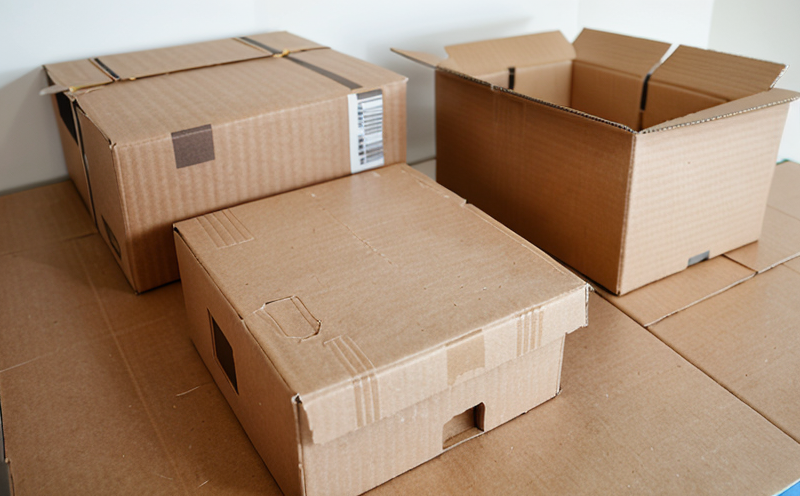ISO 1974 Water Vapor Transmission Rate (WVTR) Testing
The ISO 1974 standard provides a robust framework for testing the water vapor transmission rate of packaging materials, particularly focusing on paper and cardboard. This service is critical in ensuring that packaging meets stringent moisture barrier requirements, which are essential for maintaining product quality during storage and transportation.
Water vapor transmission testing is widely used across sectors including food and beverage, pharmaceuticals, electronics, and consumer goods. For instance, in the food industry, accurate WVTR measurement ensures that packaged products remain fresh by preventing moisture from compromising the integrity of the packaging or affecting product quality.
The test involves measuring how much water vapor passes through a specified area of material over time under controlled conditions. The apparatus typically consists of a permeation cell where the sample is sealed between two plates, one impermeable and the other allowing for vapor passage. Temperature and humidity are carefully regulated to simulate real-world storage environments.
Preparation of the specimen is crucial for accurate testing results. Samples must be preconditioned to ensure they are at equilibrium with the test environment before testing begins. This involves conditioning samples in a controlled atmosphere chamber where temperature, relative humidity, and pressure are precisely set according to ISO 1974 guidelines.
The permeation cell is then pressurized, sealing the sample between two plates. The apparatus maintains constant temperature and humidity levels while monitoring vapor transmission across the sample. The rate of water vapor migration through the material is calculated based on changes in mass or pressure within the permeation cell over a specified time period.
The results are reported as grams per square meter per day (g/m²/day), providing a clear measure of the packaging's moisture barrier performance. Compliance with specific standards like ISO 1974 is essential for ensuring that products meet regulatory and quality requirements, thereby enhancing consumer safety and satisfaction.
Accurate WVTR testing also supports research and development efforts by enabling continuous improvement in packaging design. By identifying weak points or optimizing materials, manufacturers can enhance the performance of their products. This not only extends product shelf life but also reduces waste and costs associated with product spoilage.
Customer Impact and Satisfaction
Clients who opt for ISO 1974 WVTR testing benefit from enhanced product quality, which directly translates to higher customer satisfaction. By ensuring that packaging effectively prevents moisture intrusion, the risk of product spoilage is minimized, leading to better preservation and longer shelf life.
Compliance with international standards like ISO 1974 also enhances brand reputation by demonstrating a commitment to high-quality products and responsible manufacturing practices. This can attract more discerning consumers who value sustainability and reliability in their purchasing decisions.
In addition, accurate WVTR testing supports supply chain efficiency by reducing the need for frequent replacements of compromised packaging. This reduces operational costs while maintaining consistent product quality throughout distribution channels.
Competitive Advantage and Market Impact
By offering ISO 1974 WVTR testing, laboratories provide a critical service that can significantly enhance competitive positioning in the market. Meeting regulatory requirements demonstrates compliance with industry standards, which is increasingly important for regulatory approval and market entry.
The ability to consistently deliver high-quality products with effective moisture barriers sets companies apart from competitors who may not meet these standards. This not only improves product performance but also enhances brand loyalty among consumers who appreciate the reliability of the packaging.
Moreover, by investing in state-of-the-art testing facilities and expertise, laboratories can provide a unique service that is difficult for smaller players to replicate. This allows larger corporations to differentiate themselves in competitive markets, ultimately leading to increased market share and profitability.
Use Cases and Application Examples
| Application Example | Description |
|---|---|
| Fresh produce packaging | Paper and cardboard materials are used to protect fruits and vegetables from moisture loss during storage and transport. |
| Medicinal product containers | Effective WVTR testing ensures that medications remain stable by preventing excessive moisture ingress. |
| Electronics packaging | Paper-based materials are used to protect delicate electronic components from humidity damage during handling and use. |
| Bakery products | Packaging must prevent moisture loss while also allowing for some gas exchange to maintain freshness. |
| Pharmaceutical blister packs | Paper and cardboard backing ensures that the medication remains dry, enhancing stability during storage. |
| Cosmetics containers | Maintaining product integrity by preventing moisture from compromising the formulation is crucial for cosmetic packaging. |





